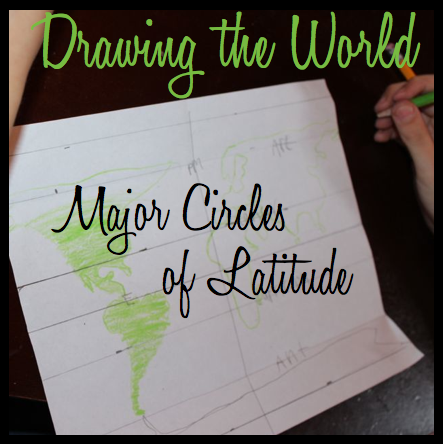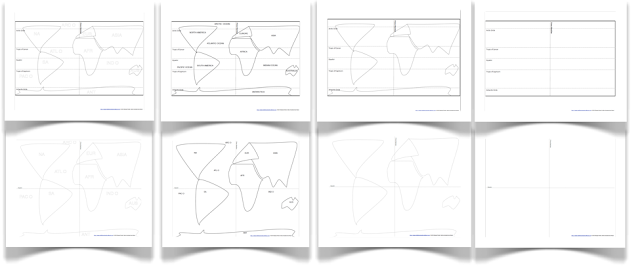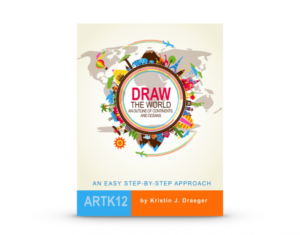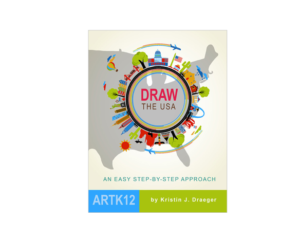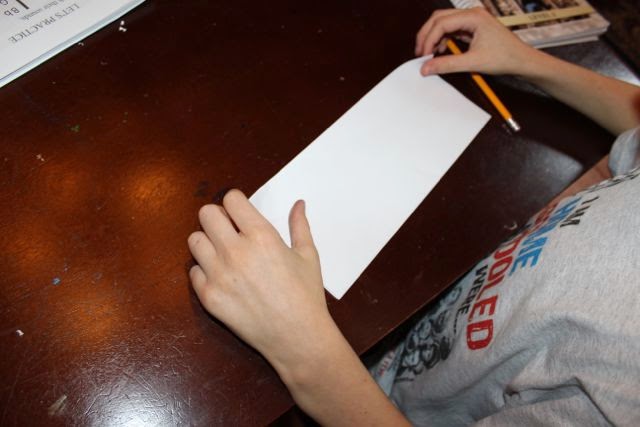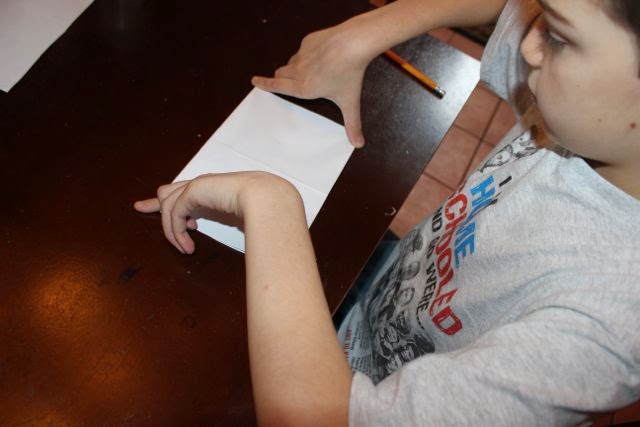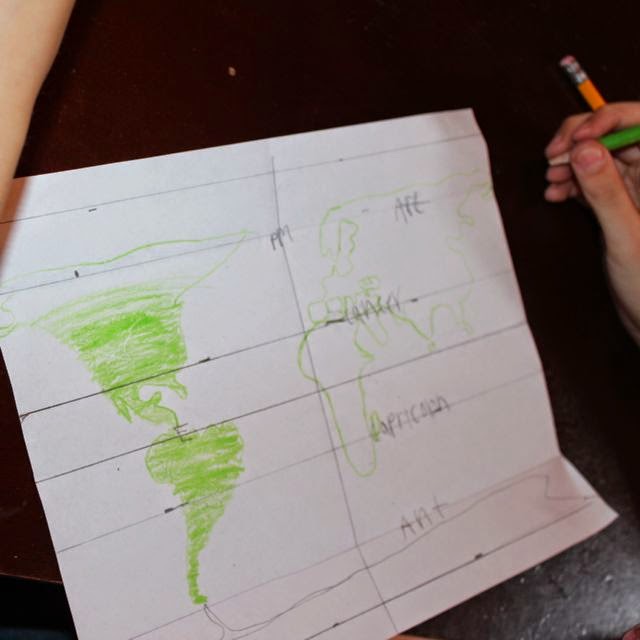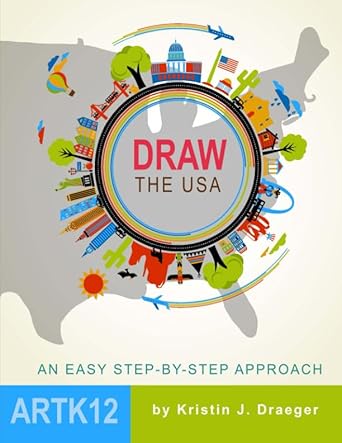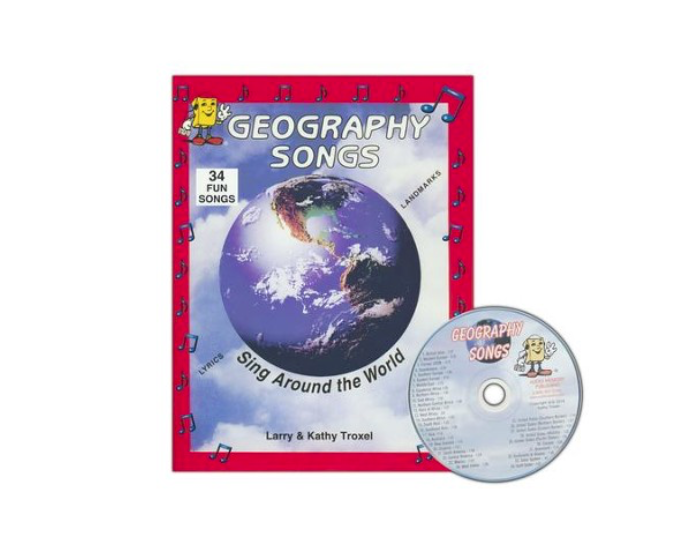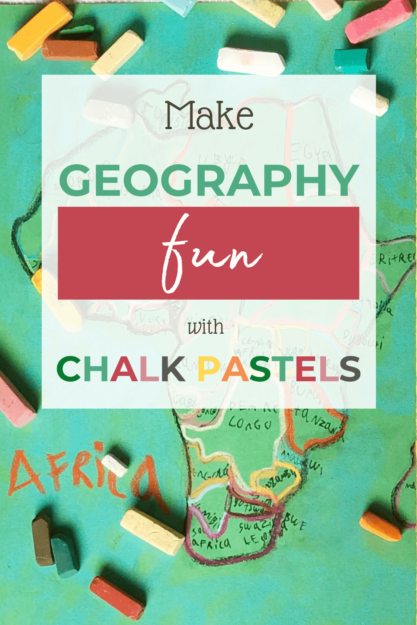Our family has been working on map-drawing for a couple of years now. When we were studying American history three years ago, our family only traced the US Map, and our oldest (as a 7-year-old) learned to draw in the U.S. physical features free-hand from memory. We first focused on the world map and started using “Continental Blobbing” during our world history studies.
The reason I bring up drawing the world right now is because we are currently reading The Core which recommends starting with learning to draw the Great Circles. In fact, this book recommends the following for mastering the world map by 8th grade:
“Once a week draw and label these maps. Another time each week, review the maps the students drew while younger.
[Kindergarten: The Great Circles & world blob map]
First Grade: Australia
Second Grade: South America
Third Grade: Africa
Fourth Grade: North America
Fifth Grade: Europe
Sixth Grade: Asia
Seventh Grade: World Map
Eighth Grade: Indonesia and Antarctica” (p. 160-162)
“For parents and teachers who are worried because their children are older, try one continent per semester. If you are an adult or high school student, try drawing a continent for two weeks each and you’ll be done in a semester.” (p. 162)
“This could take a month of half-hour daily lessons for a teenager, or seven years of weekly lessons if the child starts as a five-year-old. The final goal is to draw the world by heart (from memory) with at least two hundred features accurately labeled.” (p. 160)
The simplest method of learning to draw the world freehand is to trace the maps you are currently working on in your homeschool; your child will learn quite a bit just by tracing maps. I’d recommend tracing the USA (or the maps for whichever region you’re studying), eventually leading up to drawing it free-hand. If/when you feel comfortable with it, you can introduce blob mapping to your children this year (once per week?), as it is much simpler than you’d think, especially if you use the templates provided in our continental blob map packet. If it is currently too overwhelming to include map-drawing in your school day, just wait and add in map practice when you are ready.
The Great Circles
The recommended method of learning the Great Circles is to line up a piece of paper with an atlas and extend the lines across the paper. Likewise, the recommended method of memorizing the world map is to look at an atlas and transpose each continent onto a piece of paper. The Core contains detailed instructions on how to draw the Great Circles and add the continents to it. It also includes a simple plan to master drawing the world by heart with “at least two hundred features accurately labeled” by the time your child enters high school.
I was one of those people who had trouble visualizing the instructions for map-drawing. In the end, our family used baby steps in map-drawing because it was the only way I knew how to start.
Our family’s baby steps to map-drawing:
- As beginners, we practiced tracing pre-printed maps either with dry erase markers or by using tracing paper. (My method? Start somewhere! Anywhere! Just start!)
- Eventually, we started practicing blob mapping using our continental blob map templates. My goal for these templates was to burn an image in our minds of the general shape of each continent and where they cross each of the Great Circles and Prime Meridian. After tracing the blob map templates a handful of times, our two oldest started drawing blob maps from memory and then comparing the finished product to the template to make corrections. After mastering the general shape of the continents, they started comparing their blob maps to pre-printed maps and adding in further details to each continent.
- From there, we started to make our own map projections based on the major circles of latitude. Here we show how to make a map of the Great Circles (or Major Circles of Latitude) using paper, pencil and a ruler. (I preferred being able to draw the major circles from scratch so that we would not need to depend on external references when drawing maps from memory.)
After your student has a concept of the world with blob mapping, you will want to focus on drawing each continent in greater detail. For this, we recommend Draw the World.
During our study of American history we use Draw the USA to memorize the states. It’s a great way to simplify memorizing how to draw the USA free-hand. In fact, we recommend the entire Draw the… [Continent] books by Kristin Draeger.
Drawing the World Free-hand: How to make a map of the Great Circles
Draw the Equator and Prime Meridian. Using a blank 8.5″ x 11″ piece of paper, fold in half lengthwise and widthwise:
Trace these lines. The horizontal line is the Equator and the vertical line is the Prime Meridian. Label (younger children can use abbreviations).
For my youngest two children, we only used the equator and prime meridian as our guideline for learning to create a blob map. You can see those templates here.
Add the Tropic of Cancer and Tropic of Capricorn. Using a ruler, measure 1 inch above the equator and draw a line. Label as the Tropic of Cancer. Measure 1 inch below the equator and draw a line. Label as the Tropic of Capricorn.
Add the Arctic Circle and the Antarctic Circle. Fold top of paper so that the edge lines up with the Tropic of Cancer. Unfold and trace the line made by the fold. This is the Arctic Circle. Label.
A MATHEMATICAL NOTE: Proportionately drawn, the distance between the equator and Tropic of Cancer is 1 inch, the distance between Tropic of Cancer and Arctic Circle is approximately 1.8 inches, and the distance between the Arctic Circle and North Pole is 1 inch (see calculations at bottom of this post). However, to minimize the amount of measurement needed, we fold the paper over to measure off our arctic and antarctic circles. Although this is a bit inaccurate, it’s quicker and simpler to do. (In this fold-it-over method, the distance between the tropics and arctic/antarctic circles is 1.625 inches instead of the more accurate 1.8 inches. If this mathematical note confuses you, just ignore it. I’m not sure I’m making much sense right now.)
If you would like more accuracy in your proportions, instead of folding as shown below, measure up from the Tropic of Cancer 1.8″ (or 1 13/16″) to mark off the Arctic Circle, and measure down from the Tropic of Capricorn 1.8″ to mark off the Antarctic Circle.
Fold bottom of paper so that edge lines up with Tropic of Capricorn. Unfold and trace the line. This is the Antarctic Circle. Label.
The great-circles map can be used as it is at this point (as shown below)….
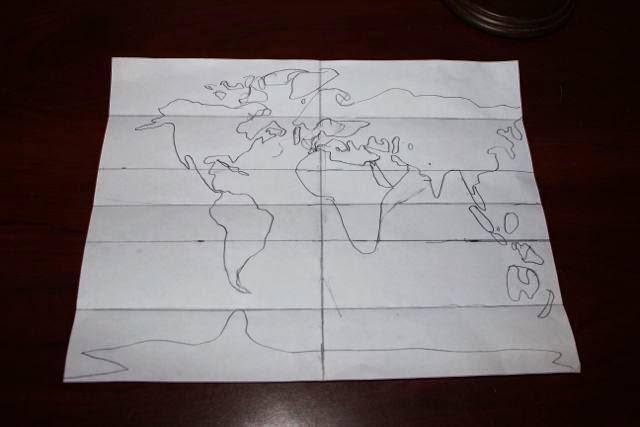
…OR you can add more accuracy by measuring down one inch below the antarctic circle and one inch above the arctic circle to create an edge to the map.
Disclaimer: The thing to remember is that we are transposing a three-dimensional object onto a two-dimensional piece of paper. Map projection is an estimated method of representing the globe on paper, so it will not be fully accurate. (We all know that Alaska is stretched beyond it’s actual size on the globe because the farther we are from the equator, the more skewed the continents will be.)
For those who wish to know the calculations behind our method of map projection…
Background information:
Each degree of latitude is approximately 69 miles. (The earth’s circumference is 24,901 miles, so 24,901 miles / 360 degrees = 69.17 degrees)
The equator is at zero degrees latitude.
The Tropics are at approximately +/- 23.5 degrees latitude.
The Arctic and Antarctic Circles are at approximately +/-66.5 degrees latitude.
The North and South Poles are at +/-90 degrees latitude.
Distance Calculations (Approximate):
Distance from equator to Tropics:
69.17 miles/degree x 23.5 degrees = 1625 miles
Distance from equator to Arctic/Antarctic Circles:
69.17 miles/degree x 66.5 degrees = 4600 miles
Distance from equator to North/South Poles:
69.17 miles/degree x 90 degrees = 6225 miles
Map Projection Calculations (Approximate):
If map distance from equator to Tropics is one inch on paper, then…
Let x = Map distance from equator to Arctic/Antarctic Circle
map = map
actual actual
1 inch = x inches
1625 miles 4600 miles
x = 2.83 inches
Let y = Map distance from equator to poles
1 inch = y inches
1625 miles 6225 miles
y = 3.83 inches
Therefore, proportionately drawn, the distance between equator and tropics is 1 inch, distance between tropics and arctic/antarctic circles is 1.8 inches, and the distance between arctic/antarctic circles and poles is 1 inch. However, to minimize the amount of measurement needed above, we fold the paper over to measure off our arctic and antarctic circles. In this case, the map distance between the tropics and arctic/antarctic circles is 1.625 inches.
If any other mathematicians or cartographers find any errors in my methods, please feel free to contact me, as I am functioning on a sleep-deprived mind as I write this!
For more detailed instructions, grab a copy of Draw the World and/or Draw the USA.
For more detailed instructions, grab a copy of Draw the World and/or Draw the USA.
 Draw the World
Draw the World
Learn to draw the world from memory! Draw the World provides students with a simple method of committing a continent outline map of the world to memory. Through simple, step-by-step instructions, students learn to draw each continent as it connects to neighboring continents. This resource is also used in the Mission Pacific Peacemakers Six-Week Unit Study.
Suggested grades: Elementary through High School
Price: $19.95
Format: Paperback.

Draw the USA
Learn to draw and label the United States of America from memory! Draw the USA provides students with a simple method of committing the map of the USA to memory. Through simple, step-by-step instructions, students learn to draw each state as it connects to neighboring states. This resource is used in Units 5 & 6 of our Mission: Lasting Liberty curriculum.
Suggested grades: Elementary through High School
Price: $19.95
Format: Paperback.
![]()
In elementary school, our youngest children ended up memorizing all the countries of the world through Kathy Troxel’s Audio Memory Geography Songs CD/Booklet, which is used in our Mission: World Wondersand Mission: Faith Forgerscurriculum plans. Highly recommended!
Geography Songs CD, Book, & Map Kit
Memorize the world through song! Divided by geographical regions, these echo-style songs make it simple to memorize the countries of the world. The audio CD includes 34 songs that teach the names of 225 countries, the continents & oceans, and the planets of the solar system. This resource is used in our Mission: World Wonders and Mission: Faith Forgers curriculum.
Suggested grades: Elementary through Middle School
Price: $22.95
Format: Kit consists of an audio CD, a 25″ x 36″ world map with items to label and song lyrics, and a family-reproducible workbook with lyrics and maps. Purchase here on Christian Book Distributors.

You may also be interested in…
Continental Blob Map Templates
TableTop Geography
Reviewing Geography with LEGOs, beans, and trash
U.S. Geography Resources
U.S. Geography States & Capitals File Folder Game
To learn to draw the USA, we use Draw the USA by Kristin Draeger. To learn how to draw each continent freehand, check out the Chalk Pastels Membership (which includes hundreds of simple art projects to reinforce history, literature, science, and other subjects.) For more resources for world geography, world missions, and world cultures, visit the geography section of our website.
This articles was originally written in July 2014.

